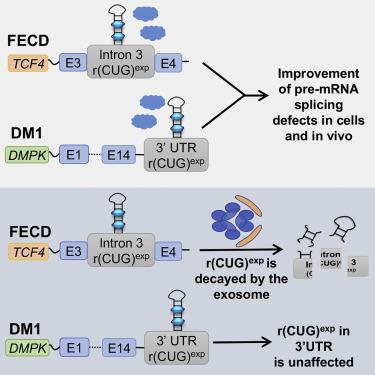Cell Chemical Biology ( IF 8.6 ) Pub Date : 2020-11-05 , DOI: 10.1016/j.chembiol.2020.10.007 Alicia J Angelbello 1 , Raphael I Benhamou 1 , Suzanne G Rzuczek 1 , Shruti Choudhary 1 , Zhenzhi Tang 2 , Jonathan L Chen 1 , Madhuparna Roy 3 , Kye Won Wang 4 , Ilyas Yildirim 4 , Albert S Jun 3 , Charles A Thornton 2 , Matthew D Disney 1

|
Many diseases are caused by toxic RNA repeats. Herein, we designed a lead small molecule that binds the structure of the r(CUG) repeat expansion [r(CUG)exp] that causes myotonic dystrophy type 1 (DM1) and Fuchs endothelial corneal dystrophy (FECD) and rescues disease biology in patient-derived cells and in vivo. Interestingly, the compound's downstream effects are different in the two diseases, owing to the location of the repeat expansion. In DM1, r(CUG)exp is harbored in the 3′ untranslated region, and the compound has no effect on the mRNA's abundance. In FECD, however, r(CUG)exp is located in an intron, and the small molecule facilitates excision of the intron, which is then degraded by the RNA exosome complex. Thus, structure-specific, RNA-targeting small molecules can act disease specifically to affect biology, either by disabling the gain-of-function mechanism (DM1) or by stimulating quality control pathways to rid a disease-affected cell of a toxic RNA (FECD).
中文翻译:

结合 RNA 重复扩增的小分子通过外泌体复合物刺激其衰变
许多疾病是由有毒的 RNA 重复序列引起的。在这里,我们设计了一种先导小分子,它与 r(CUG) 重复扩展 [r(CUG) exp ] 的结构结合,导致 1 型强直性营养不良 (DM1) 和 Fuchs 角膜内皮营养不良 (FECD) 并挽救患者的疾病生物学衍生细胞和体内。有趣的是,由于重复扩增的位置,该化合物的下游效应在这两种疾病中是不同的。在 DM1 中,r(CUG) exp位于 3' 非翻译区,该化合物对 mRNA 的丰度没有影响。然而,在 FECD 中,r(CUG) exp位于内含子中,小分子促进内含子的切除,然后被RNA外泌体复合物降解。因此,结构特异性、靶向 RNA 的小分子可以通过禁用功能获得机制 (DM1) 或通过刺激质量控制途径来消除受疾病影响的细胞中的毒性 RNA,从而特异性地作用于疾病以影响生物学。 FECD)。


























 京公网安备 11010802027423号
京公网安备 11010802027423号